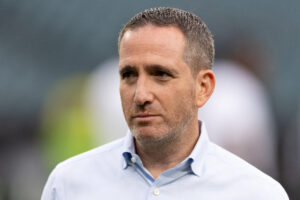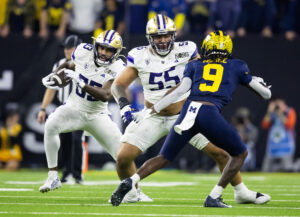Relocation news has went from a flood to a drip in the last few weeks since Hurricane Adelson hit. Sheldon Adelson walking from the deal and then using his clout and media resources to make things uneasy for Mark Davis and his relocation plans has been a pain. And caused Goldman Sachs to “Unofficially” search for the nearest shelter.
Stadium Economics: Oakland’s Financial Difficulty
When the Al Davis brought the Oakland Raiders back home in 1995 he borrowed $63.9 million to move. He also signed a 16 year lease under the belief that PSLs would be sold out, and once that lease was fulfilled that the Raiders would get new digs. Unfortunately for all parties the PSL sales were a disaster that lead to back and forth lawsuits for years. Any talks of building a new stadium after the lease expired, during that time, were silenced by them.
To make matters worse, the Raiders on the field performance fell off a 14 year cliff during Superbowl XXXVII. the 2016 NFL season was the first winning season, and return to the playoffs since the Superbowl disaster in 2003. This resulted in ticket prices going from one of the highest in the NFL, to one of the lowest. Even with that, to date, there have been 87 T.V. blackouts since the team returned. Even during the “Good years” selling out was never easy. This forced Mark Davis to put a tarp up on over 7,000 seats in 2013.
An Explanation of the Master Lease Agreement for the Oakland-Alameda County Coliseum.
“The 1995 deal didn’t work from a financial perspective for any party to the deal — city, county or Raiders” – Amy Trask, former chief executive officer of the Raiders in 2012, to Bloomberg.com
Al Davis returned the Raiders to Oakland in 1995. Unfortunately the Oakland Athletics controlled most of the contracts with the Joint Powers Authority. This was not much of an issue until the Raider dark ages began. When tickets went unsold though, especially the high dollar suites, the lack of other stadium revenue reared it’s ugly head. Under the initial master agreement, the Raiders got very little from parking, signage, and concessions. The A’s held all the advertising space, and all the concession rights.
“Every year we pay a tremendous amount of money, some of which is deemed repayment, some of which is revenue they receive as a result of us playing in the facility. When you add together everything the city and county received pursuant to our agreement and through the past 17 years, it’s literally hundreds of millions.” – Amy Trask, former chief executive officer of the Raiders in 2012, to Bloomberg.com
The Raiders Started to Realize They Had a Pretty Bad Stadium Deal.
In 2005, with ticket money plummeting with the Raiders record, Al needed to get more out of their stadium and their brand. So they pushed for more money out of the master lease. What they got was “Four” signage spots on the Coliseum fascia, and a 50-50 split, with the JPA, on parking revenue and concession revenue. The 50% that the JPA collects for this offsets the 1995 Loan Agreement between the Raiders and JPA. For this the Raiders had to extend their lease agreement two more years.
This new addendum still did not offset the lack of on the field excitement for the Raiders. In Fact, Al Davis had to sell 20% of the team to three east coast investors in 2007. Al did this to ensure Mark had the liquidity needed to take over the team when he passed.
In 2013 the Raiders and JPA extended the Master Agreement for two more years. They also amended it further by stipulating the Raiders could play one home game somewhere other than the Coliseum. The reason for this is simple. Money. The Raiders earn a lot more revenue playing a home game internationally than in Oakland. One other addendum of note. The Raiders and JPA agreed that should the Raiders relocate, the ownership of the Training facility would be transferred to the government. This transfer would satisfy any outstanding debts between the Raiders and government.
By 2015, Mark Davis Had Finally Reached the Limit to His Patience.
The 2015 agreement, The JPA capped the Raiders concession revenue at $1.15 million a year. Once the cap is exceeded the split goes 70% to the JPA, and 30% to the Raiders. However the Raiders did manage to secure additional revenue. The Raiders were finally allowed to retain 100% of all game day digital ad revenue and changeable signage.
The latest lease agreement, in 2016, was signed after first being vetoed by Oakland. The only major amendment was the lease went up from $400k a year to $2.975 million a year without any offsetting revenue for the Raiders. The Raiders were already dead last in stadium revenue when this lease was signed. This only further exasperated the need for a new stadium. The Raiders average about $40-$50 million in total stadium revenue.
After the 2016 NFL season the Raiders announced that they will be raising season ticket prices from an average $63 dollars per game to an average $87 dollars per game. This is still 13% below the average NFL ticket price. Still not a bad deal.
Switching Gears: People Often Ask Why It Seems So Easy for Mark to Finance in Las Vegas, but Won’t Try in Oakland.
On the surface that seems like a reasonable question. However the differences become much more apparent with a little financial digging. Lets tackle this from a bank’s perspective.
Financing in the Bay Area, and economic juggernaut of a region, should seem much easier for the Raiders. If you include San Jose, the Bay Area boasts the 3rd largest GDP in the U.S. and 17th in the entire world. Not only that, but it is number one in economic growth. Seems pretty cut and dry, but it isn’t.
First and foremost is having control of a location to build on. Business success is all about location. Unfortunately for the Oakland Raiders the primary location, the Oakland-Alameda County Coliseum, is not, and will not, be controlled by either the NFL, or the Raiders. That is because the city of Oakland and county of Alameda, are set to give Fortress Investment Group exclusive negotiation rights to develop that location. According to Bob Singer, Spokesperson for Fortress, that should happen on February 28th. That exclusive agreement makes it extremely difficult to bring in outside financing.
What about another location in the Bay Area? Well the Raiders did a lot of research into other locations but they ran into difficulties. The cost of even a small footprint stadium is around 1.3 Billion dollars and the Raiders only have $500 million to put up. That leaves $800+ million for a bank to finance. Then there is the competition for non football events. In the Bay Area there are 4 other large event venues. Stanford, Cal, Levi, and San Jose. Because of that, and because of the small stadium footprint, there is a limited amount of non Football events, and much more competition for them.
Small Stadium Footprint Limits Revenue.
A smaller stadium, with fewer suites, also limits the amount of football revenue. According to Business Insider the ideal amount of professional sports team in the Bay Area is four. Currently there are six teams, and if you include MLS, seven. Because of that over saturation it makes it much more difficult to get long term, high dollar, commitments for suites and sponsorships, especially in an East Bay venue.
From a bank’s perspective, all the above limits revenue streams. And using an estimated 6% interest rate over 30 years, Loan payments on $800 million would be in the range of $57.5 Million a year. Granted this is an example and using an arbitrary figure, and more than likely it would be stadium bonds, but it should add some context, especially from a bank’s viewpoint. Also understand that the NFL will not allow Mark to use the team as collateral, and the Venue itself, is not good enough with limited revenue streams.
So because of this, it makes it extremely unlikely that the Raiders could finance anywhere in the East Bay. Remember, the West Bay is the territory of the San Francisco 49ers and off limits.
That Makes Fortress and the Coliseum Site as the Only Hope to Keep the Raiders in the Bay Area.
Unfortunately this has not been a workable solution for the NFL or the Raiders. At least not yet.
Without raising anyone’s hopes, as long as there is real money at the table, and by all accounts Fortress has the cash, then there remains a possible solution. However remote that may be. The door is not fully closed.
With that said, there are major roadblocks here. First there is control of the land. The NFL has not been satisfied with Fortress controlling the land. Then there is what Fortress wants for its $800+ million dollar investment. A stake in the Raiders, and reports vary from 20%-40%. Again Mark Davis and the NFL have both said this is a non starter. Also Fortress owns a stake in the Milwaukee Bucks. The NFL is against owning other pro teams that are out of market, and they also view the investment as a “loan to own” situation, which NFL Owners have quietly said is a deal breaker.
Second neither the city or county is putting up public funds directly for the stadium, however they do want a revenue share. Not only that they also want to use Stadium Revenue Bonds to pay back any money spent on none stadium infrastructure.
For the Raiders, they were already willing to limit future revenue by building a 55k capacity stadium. Losing any more revenue makes this financially unfeasible for them for the money they would bring to the table. They feel this would endanger the teams financial future, and could cause them to become a second class team like the Athletics have been for years.
Athletics Still Have Not Chosen a Site.
Speaking of the Athletics, that is another sticking point for the NFL. The A’s have not decided where they want to build their ballpark, and the Coliseum site is considered their leading location.
Last but not least, the Fortress proposal so far will not be a voted on inked offer. Anything they negotiate must then be taken back to Oakland and Alameda for final approval. This is a major point of contention with many NFL Owners. They want to see an inked plan and want to be the final arbiter of said plan. For example, should the NFL see a plan they like, they want it to be actionable immediately.
Anyways, Eric Grubman still checks in on the Fortress plan, and the NFL has not shut the doors on that option. A lot of compromise is needed though on positions both sides have continued to entrench themselves on. For Oakland fans, a real miracle needs to happen, to keep the Raiders from moving.
Ronnie Lott still has hope, so there is that.






